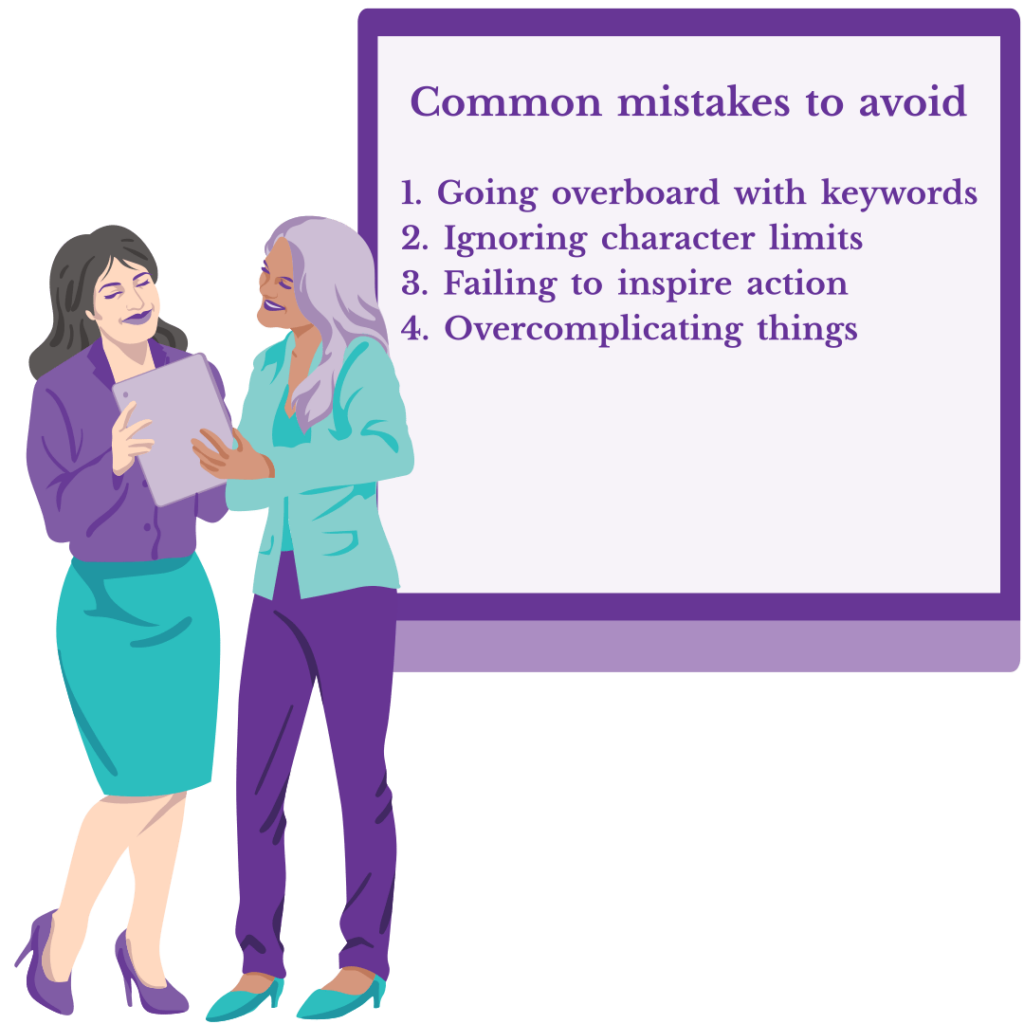So, you’ve got an incredible website and top-notch content, but you’re still not seeing the organic traffic you’ve been dreaming of? Ever wonder why your pages don’t seem to rank as high as they should in search engine results? One often overlooked element that could be the cause of your SEO woes, could be your SEO titles. When crafted correctly, these hidden gems not only catch Google’s attention but also make your audience eager to click through to view your content. Imagine boosting your organic reach, just by nailing the perfect title for your search listing. Intrigued? Stick around, and you’ll discover how the power of a well-crafted SEO title (or title tag, since that’s the bit you actually write) can seriously elevate your search rankings, and ultimately, your business. Read on to find out how to give your site the SEO title treatment it deserves or listen to the audio.
What are SEO titles?

Ever found yourself scanning through a list of Google search results, trying to figure out which piece of content might have what you’re looking for? You may even have done that before clicking through to this article. Remember those clickable headlines you saw in each search result? Yep, those are SEO titles. Now, let’s break down what this really means.
SEO, or Search Engine Optimisation, is the practice of increasing the visibility of your website on search engines like Google and ensuring your content provides the best experience for your human visitors. Many SEO techniques are performed on the content your audience is actually going to consume. But it’s the title of a search listing — that small yet impactful line of text — that can grab someone’s attention and compel them to click through to your content. The better the title, the higher the chances of your page getting noticed in the sea of search results.
Now, you can’t tell search engines that they must use a certain SEO title. But you can write a title tag that tells them what title you’d like them to display, and if it’s a good title, they’re highly likely to use it. (A title tag is a little piece of code that your visitors won’t see on your page but which search engines can interpret. Thankfully, you don’t need to know how to code to write title tags.) So, when people talk about optimising an SEO title, what they’re really talking about is optimising the title tag.
The words you choose to use in your title tag aren’t just there to entice search users and convince them to explore your content. They also tell search engines what you believe your content is most heavily focused on. This helps search engines figure out when they should show your content and thus your title tag can heavily impact your search rankings.
So when we talk about the importance of SEO titles, we’re really talking about first impressions — for humans and search engines. And in the digital world, you only get one shot at that.
Why do SEO titles matter?

Think of SEO titles as the headlines of newspaper articles. Just like you’d skim through headlines to decide which stories to read, people scan SEO titles to decide which link to click. Effective titles act as a quick summary of what the page contains, enticing the reader while also being relevant to their search query. Failing to create an engaging and descriptive SEO title can result in lower click-through rates, which in turn can affect your website’s overall SEO performance.
In essence, SEO titles serve as a snapshot of your content. They help search engines understand what your page is about, and equally important, they help potential visitors decide whether your page is worth visiting. They’re your first, and sometimes only, chance to attract and engage your target audience.
If you don’t supply title tags for search engines to use, they will write their own. And what a search engine writes may not accurately reflect what your page is about or offer a compelling reason for your audience to click through to that page.
The role of unique SEO titles in search rankings

Many of the people who reach out to K. M. Wade asking for an SEO audit, seem to have grasped the importance of having a good SEO title but make the mistake of reusing their best ones across several pieces of content. You see, it’s not just writing a title tag that’s important. You also have to write a unique title tag for every page. To understand why, you need to understand how search engines work.
When search engines crawl your website, they use algorithms to determine how relevant and valuable your content is. Unique titles are an essential element here because they help differentiate your content from the sea of similar articles and pages online. Importantly, they also distinguish your content pieces from each other. I’ll illustrate this with an example.
I once had a client who asked me to write a detailed and comprehensive 3000-word article about some key changes in their industry that were highly relevant to their audience. When I’d finished, they signed off on the post and then decided to split it into four separate blog posts because they thought 3000 words was too much for their audience to read in one sitting. Whether that was a good idea is hard to tell because the brand has a very limited understanding of their target audience. They did make one terrible mistake though.
They used the title tag and meta description I’d written on all four blog posts.
It was a disaster.
The title tag most closely aligned with the topics that ended up in the third blog post. As a result, that was the only post that ranked because Google decided that blog post was the most relevant to the message in the title tag and therefore there was no reason to share the other blog posts, which after all, were more indirectly related to the title tag.
Imagine for a second, I split this article up into multiple posts and gave each the title tag ‘Why SEO Titles Matter for Your Business Growth | K. M. Wade’. The last section would end up being a discussion of title tag best practices. And while that’s relevant to the topic, it’s definitely not what you’d expect to find as the only inclusion in a blog post about why SEO titles matter.
If they’re to be as effective as possible, SEO titles must accurately reflect the content they’re promoting and that means they need to be unique. If you feel a single title tag works best for two pieces of content, your title tag either isn’t specific enough or the two pieces of content are so similar that they should really be combined into a single piece.
How duplicate title tags impact search rankings
Search engines like Google are always looking to provide the most accurate, relevant, and helpful results for their users and duplicate title tags interfere with that objective. Why? Imagine two articles (from different brands) that cover the same topic and have identical or very similar SEO titles. How will search users know which search listing to click on? Unless they happen to be familiar with the brands, they’ll have no way of knowing which piece of content is more relevant to their needs. Google will resolve this by writing a different SEO title for one or both of the articles.
Each new SEO title may be compelling. Or it might not. If you’ve ever played around with an AI text generation tool, like ChatGPT, you’ll probably understand that the quality of text writing by computers is highly variable. Google sometimes does a decent job. Many other search engines do a pretty poor job. So if you want good results from organic search, you’re better off writing a title tag search engines are more likely to use.
There’s another way in which duplicate title tags can harm your search rankings — if you have two or more pieces of content on your site with the same title tag. By using the same title tags for multiple pieces of content, you basically tell search engines that each piece of content is relevant to the same keywords. This means your content pieces compete with each other in their efforts to rank for the same keywords in a process known as keyword cannibalisation.
The result of keyword cannibalisation is impaired rankings for all competing pieces of content. So, something to be avoided!
A quick heads-up on title uniqueness
It’s worth noting that title uniqueness doesn’t mean just swapping out a word or two. It involves crafting a title that captures the unique angle or viewpoint of your content. Whether it’s a how-to guide, a product review, or an insightful article, your title should encapsulate what sets your content apart. Each title tag should also be optimised for a keyword you haven’t targeted before on your website.
Crafting the perfect SEO title

Creating the perfect SEO title isn’t just about throwing a few keywords into a sentence and calling it a day. It’s a delicate balance of science and creativity. You’ve got to incorporate keywords, sure, but you also need to write a title that real humans want to click on. And you have to keep it below a certain size. In fact, there’s a lot going on in a title tag, so here’s an overview of the key things to consider.
The importance of keywords in title tags
Let’s start with the basics: your keywords. Since you’re optimising title tags for search engines, including your target keywords is essential. These should ideally be located towards the beginning of your title to catch both Google’s and your readers’ attention right away. For example, if your keyword is ‘best hiking boots’, an effective title tag might be something along the lines of ‘Best Hiking Boots: The Ultimate Buying Guide’.
Add value propositions
But why stop at keywords? Give your audience a reason to click by incorporating a value proposition. This could be something like ‘affordable’, ‘easy-to-use’, or ‘award-winning’. Going back to our hiking boots example, an enhanced title could be ‘Best Hiking Boots: The Ultimate Guide to Award-Winning Footwear’.
Mind the length
Ever seen those titles in search results that get cut off and end in an ellipsis (…)? You want to avoid that. Google typically shows about 50-60 characters of a title in its search results. (The exact number of characters depends on exactly which characters you use.) If your title is too long, it will get truncated and may lose its impact. Keep it concise while still including the necessary information.
Test and tweak
Lastly, don’t shy away from A/B testing your titles. You can use various tools for this, such as Google Search Console, to see which titles are getting more clicks. The more data you have, the better you can optimise your future titles.
Common mistakes to avoid

Duplicating title tags across multiple pages on your site and copying another brand’s SEO titles are both fairly common SEO issues. Here are some more granular issues that could get you into hot water.
Going overboard with keywords
Keyword stuffing is a cardinal sin in the world of SEO. Sure, you need keywords in your title, but jamming them in haphazardly can make your title unreadable and put off potential clicks. Plus, Google is smart enough to know when you’re trying too hard and your rankings will suffer as a result.
Ignoring character limits
We touched on this before, but it bears repeating: keep an eye on your character count. Google usually shows 50-60 characters in its search results. If your title gets truncated because it’s too long, you’re essentially wasting precious real estate.
Failing to inspire action
Your title is your first impression. If it doesn’t encourage users to click, then even the most well-crafted article is moot. Try to incorporate action words or compelling descriptors that trigger curiosity or urgency.
Overcomplicating things
It’s easy to get carried away trying to make the perfect title. But sometimes, simplicity is key. Your title should be easy to read and understand. Don’t use jargon or complex words that could alienate your audience.
Wrapping up your journey to SEO mastery

Alright, we’ve covered a lot of ground, so let’s pull it all together.
We’ve unpacked the value of unique SEO titles, showing you how they’re more than just a tag in your site’s code. These little champions are your first handshake with both Google’s algorithms and your future audience. Ignoring them, or reusing them, could cost you valuable organic traffic.
We’ve also laid down some best practices for crafting the perfect title and pointed out the pitfalls to steer clear of.
Now, the ball’s in your court. It’s time to start writing your own magnetic title tags.
If you’d like more detailed information about how to write title tags that drive website traffic, or you’d like to understand how you can write the other parts of your search listings as well, check out our Write Better Search Listings Course, which details everything you need to know to craft search listings that will maximise your organic search traffic — from the basics of keyword research right through to measuring the performance of your search listings. (And if you’re thinking the name is pretty simple, that was deliberate. Just as the title of the course is simple, so too do the lessons make writing title tags and meta descriptions simple.)
Well, what are you waiting for? The only way to master a new skill is to get out there and practice. So, pick a page on your site and start writing a title tag for it. And don’t forget the K. M. Wade Learning Centre is there if you need a bit more support.
